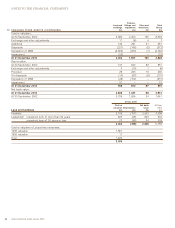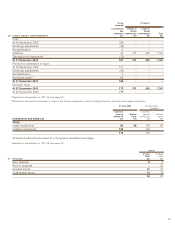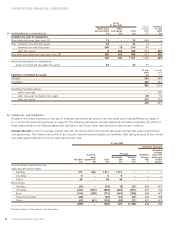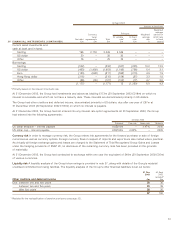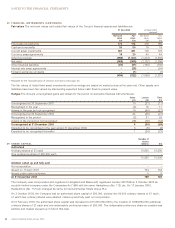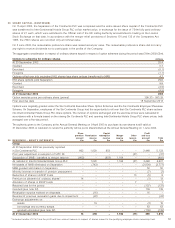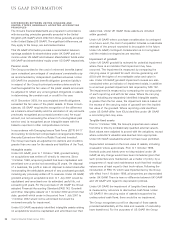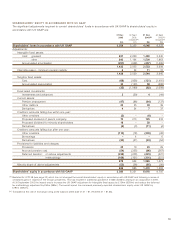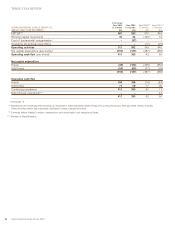Holiday Inn 2003 Annual Report Download - page 58
Download and view the complete annual report
Please find page 58 of the 2003 Holiday Inn annual report below. You can navigate through the pages in the report by either clicking on the pages listed below, or by using the keyword search tool below to find specific information within the annual report.56 InterContinental Hotels Group 2003
US GAAP INFORMATION
DIFFERENCES BETWEEN UNITED KINGDOM AND
UNITED STATES GENERALLY ACCEPTED ACCOUNTING
PRINCIPLES
The Group’s financial statements are prepared in accordance
with accounting principles generally accepted in the United
Kingdom (UK GAAP) which differ from those generally accepted
in the United States (US GAAP). The significant differences, as
they apply to the Group, are summarised below
This US GAAP information provides a reconciliation between
earnings available for shareholders under UK GAAP and net
income under US GAAP and between shareholders’ funds under
UK GAAP and shareholders’ equity under US GAAP respectively.
Pension costs
The Group provides for the cost of retirement benefits based
upon consistent percentages of employees’ pensionable pay
as recommended by independent qualified actuaries. Under
US GAAP, the projected benefit obligation (pension liability)
in respect of the Group’s principal pension plans would be
matched against the fair value of the plans’ assets and would
be adjusted to reflect any unrecognised obligations or assets
in determining the pension cost or credit for the year.
At 31 December 2003, the accumulated benefit obligations
exceeded the fair value of the plans’ assets. In these circum-
stances, US GAAP requires the recognition of the difference
as a balance sheet liability and the elimination of any amounts
previously recognised as a prepaid pension cost. An equal
amount, but not exceeding the amount of unrecognised past
service cost, is recognised as an intangible asset with the
balance reported in other comprehensive income.
In accordance with Emerging Issues Task Force (EITF) 94-17
‘Accounting for Deferred Compensation Arrangements Where
Amounts Earned are Held in a Rabbi Trust and Invested’.
The Group has made an adjustment to debtors and creditors
greater than one year for the assets and liabilities of the Trust.
Intangible assets
Under UK GAAP, prior to 1 October 1998, goodwill arising
on acquisitions was written off directly to reserves. Since
1 October 1998, acquired goodwill has been capitalised and
amortised over a period not exceeding 20 years. On disposal
of a business, the profit or loss on disposal is determined after
incorporating the attributable amount of any purchased goodwill,
including any previously written off to reserves. Under US GAAP,
goodwill arising on acquisitions prior to 1 July 2001 would be
capitalised and amortised over its estimated useful life, not
exceeding 40 years. For the purposes of US GAAP the Group
adopted Financial Accounting Standard (FAS) 142 ‘Goodwill
and Other Intangible Assets’ on 1 October 2002 and from that
date, goodwill which arose in the period from 1 July 2001 to
1 October 2002 would not be amortised but would be
reviewed annually for impairment.
Under US GAAP, separately identified intangible assets arising
on acquisitions would be capitalised and amortised over their
useful lives. Under UK GAAP, these assets are included
within goodwill.
Under UK GAAP, where purchase consideration is contingent
on a future event, the cost of acquisition includes a reasonable
estimate of the amount expected to be payable in the future.
Under US GAAP, contingent consideration is not recognised
until the related contingencies are resolved.
Impairment of goodwill
Under UK GAAP, goodwill is reviewed for potential impairment
where there is an indicator that impairment may have
occurred. The impairment is measured by comparing the
carrying value of goodwill for each income-generating unit
(IGU) with the higher of net realisable value and value in
use. Under US GAAP, goodwill impairment reviews are also
conducted when an indicator of impairment exists, in addition
to an annual goodwill impairment test required by FAS 142.
The impairment is measured by comparing the carrying value
of each reporting unit with its fair value. Where the carrying
value, including any separately identified intangible assets,
is greater than the fair value, the impairment loss is based on
the excess of the carrying value of goodwill over the implied
fair value of the goodwill. Where reporting units identified
under US GAAP differ from IGUs identified under UK GAAP,
a reconciling item may arise.
Tangible fixed assets
Prior to 1 October 1999, the Group’s properties were valued
from time to time by professionally qualified external valuers.
Book values were adjusted to accord with the valuations, except
where a director’s valuation was deemed more appropriate.
Under US GAAP, revaluations would not have been permitted.
Depreciation is based on the book value of assets, including
revaluation where appropriate. Prior to 1 October 1999,
freehold pubs and hotels were not depreciated under UK
GAAP, as any charge would have been immaterial given that
such properties were maintained, as a matter of policy, by a
programme of repair and maintenance such that their residual
values were at least equal to their book values. Following the
introduction of FRS 15, which was implemented by the Group
with effect from 1 October 1999, all properties are depreciated
under UK GAAP. There is now no difference between UK GAAP
and US GAAP with regard to depreciation policies.
Under UK GAAP, the impairment of tangible fixed assets
is measured by reference to discounted cash flows. Under
US GAAP, if the carrying value of assets is supported by
undiscounted cash flows, there would be no impairment.
The Group recognises a profit on disposal of fixed assets
provided substantially all the risks and rewards of ownership
have transferred. For the purposes of US GAAP, the Group


